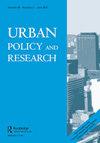Cities in COVID-19: Reconsidering Urban Form, Mobility, Housing and Planning in Australasia
IF 1.7
3区 社会学
Q4 ENVIRONMENTAL STUDIES
引用次数: 0
Abstract
Historically, global pandemics have made profound impacts on cities that lasted for generations and pushed us to reflect on and rethink how cities are lived, planned and re-oriented. The many disruptions brought in by each pandemic challenged urban growth patterns, policies and the status quo of that particular time. For example, we observed significant changes in planning and environmental control regulations in London and other European cities in the aftermath of the Great Fire in1666 [‘The great sanitary awakening’ (Winslow 1923)]. The most recent one, COVID-19 has caused unprecedented shifts in our urban life through changing mobility patterns, new forms of urban governance and pandemic response which have prompted critical questions of contemporary understandings and approaches to planning for resilient urban formations not only in relation to the city but also its hinterland areas and beyond, regional and rural centres (Ali et al. 2022, Alam and Nel 2023). While modern cities are facing complex and wicked problems, particularly in the face of climate change and the embrace of smart technologies, the outbreak of COVID-19 has been dramatic, putting urban policymakers, scholars, citizens and planners on a “pressure test” for rethinking urban planning trends, as well as highlighting existing and emergent deficiencies [Brockhoff, J. cited in Johnston (2020)]. COVID-19 cities are amplifying dialectical characteristics of invisibility and visibility, privilege and privation, selfishness and solidarity, and absence and presence (Rogers et al. 2020). In the past few years, urban life has been redefined by the ‘non-clinical panacea’ (Nahiduzzaman 2020) such as ‘lockdown’ ‘stay home’, ‘quarantine’, ‘self-isolation’, ‘social distancing’, ‘working from home’, ‘telehealth’, and ‘online shopping’. As an immediate effect, there is an unprecedented reduction in urban mobility due to the lockdown of activities, introduction of working from home and limited or online shopping. A recent survey shows around 88% of Australian employers encouraged or required their employees to work from home (Mitchell 2020). According to Grattan Institute, the crowds in the CBD of major cities on the east coast fell to a fifth or less during the height of the lockdowns (Kurmelovs 2020). This follows similar patterns of pedestrian and transport movement in major cities around the globe. For example, in London, Moscow, New York, Singapore and Milan, mobility dropped down as close to as 10% of trips during the peak of the pandemic (March 3May 5, 2020) (Statista 2020). On a positive note, a 28.3% decline in carbon emissions was recorded in Australian cities during April 2020 (Harvey 2020). The unprecedented shifts in daily urban life have prompted urban researchers and thinkers to explore ‘what a future city could look like’ (Cayford 2020). By recapturing many old debates around city structure, density, housing, social fabric, public/private space and parks, COVID-19 has compelled us to rethink how urban design and policy can transform as well as offer a more resilient and ‘pandemic-safe’ urban form. One of the key debates on post-COVID-19 cities has triggered on the preferred urban form to address the current and future crisis with enhanced resilience – compact cities or low-density suburbia? Several scholars have underscored low-density housing to practice social distancing as well as reinvigorating suburban centres with a cultural shift to working from home. The severe risk of transmission and high population death rate of some hyperdense cities2019冠状病毒病中的城市:重新考虑澳大利亚的城市形态、流动性、住房和规划
从历史上看,全球大流行病对城市产生了持续几代人的深远影响,促使我们反思和重新思考城市的居住、规划和重新定位方式。每次大流行病带来的许多破坏都对当时的城市增长模式、政策和现状提出了挑战。例如,我们观察到在1666年伦敦大火之后,伦敦和其他欧洲城市的规划和环境控制法规发生了重大变化[“卫生大觉醒”(Winslow 1923)]。最近的一次,COVID-19通过改变流动模式、新的城市治理形式和大流行应对措施,给我们的城市生活带来了前所未有的变化,这引发了当代理解和规划弹性城市形成方法的关键问题,不仅与城市有关,而且与城市腹地及其他地区、区域和农村中心有关(Ali等人,2022;Alam和Nel 2023)。虽然现代城市面临着复杂而棘手的问题,特别是在气候变化和智能技术的应用方面,但2019冠状病毒病的爆发令人震惊,使城市政策制定者、学者、市民和规划者面临着重新思考城市规划趋势的“压力测试”,并突出了现有和新出现的不足[Brockhoff, J. cited in Johnston(2020)]。新冠肺炎城市正在放大隐形与可见、特权与贫困、自私与团结、缺席与存在的辩证特征(Rogers et al. 2020)。在过去几年中,城市生活被“非临床灵丹妙药”(Nahiduzzaman 2020)重新定义,如“封锁”、“呆在家里”、“隔离”、“自我隔离”、“保持社交距离”、“在家工作”、“远程医疗”和“网上购物”。直接的影响是,由于活动的封锁、在家工作的引入以及限时购物或网上购物,城市流动性空前减少。最近的一项调查显示,约88%的澳大利亚雇主鼓励或要求员工在家工作(Mitchell 2020)。根据格拉坦研究所的数据,在封锁最严重的时候,东海岸主要城市中央商务区的人群减少了五分之一或更少(Kurmelovs 2020)。这与全球主要城市的行人和交通运动模式相似。例如,在伦敦、莫斯科、纽约、新加坡和米兰,在疫情高峰期(2020年3月3日至5月5日),出行人数下降了近10% (Statista 2020)。积极的一面是,2020年4月,澳大利亚城市的碳排放量下降了28.3%(哈维2020)。城市日常生活中前所未有的变化促使城市研究人员和思想家探索“未来城市可能是什么样子”(Cayford 2020)。COVID-19重新引发了围绕城市结构、密度、住房、社会结构、公共/私人空间和公园的许多旧辩论,迫使我们重新思考城市设计和政策如何转变,以及如何提供更具弹性和“大流行安全”的城市形态。关于后covid -19城市的关键辩论之一引发了以下问题的讨论:通过增强韧性来应对当前和未来危机的首选城市形式是紧凑型城市还是低密度郊区?一些学者强调,低密度住房可以实践社会距离,并通过在家工作的文化转变来重振郊区中心。部分人口密集城市传播风险大,人口死亡率高
本文章由计算机程序翻译,如有差异,请以英文原文为准。
求助全文
约1分钟内获得全文
求助全文

 求助内容:
求助内容: 应助结果提醒方式:
应助结果提醒方式:


